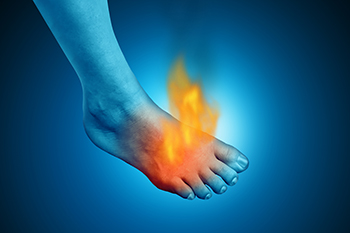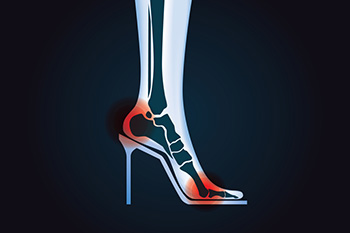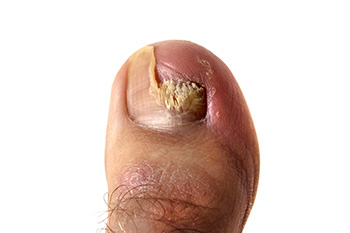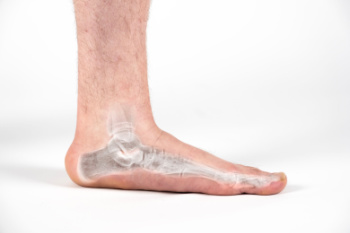Items filtered by date: January 2025
Foot Burn Wound Care

Burn injuries on the feet can occur from scalding liquids, stepping on hot surfaces, or chemical exposure. They are common in people who walk barefoot or work in environments with high heat or hazardous materials. These burns can be particularly concerning due to the foot's thinner skin and role in mobility. Immediate care involves cooling the burn under lukewarm water and gently cleaning it to remove debris. Cover the wound with a sterile, non-stick bandage and elevate the foot to reduce swelling. If you have sustained a burn foot wound, it is strongly suggested that you promptly contact a podiatrist to assess the burn's severity, prevent infection, and develop a treatment plan. Burns can lead to complications, such as infections or tissue damage, so care from this type of doctor is essential for effective healing and recovery.
Wound care is an important part in dealing with diabetes. If you have diabetes and a foot wound or would like more information about wound care for diabetics, consult with Lesly Honore, MD, DPM from New York. Our doctor will assess your condition and provide you with quality foot and ankle treatment.
What Is Wound Care?
Wound care is the practice of taking proper care of a wound. This can range from the smallest to the largest of wounds. While everyone can benefit from proper wound care, it is much more important for diabetics. Diabetics often suffer from poor blood circulation which causes wounds to heal much slower than they would in a non-diabetic.
What Is the Importance of Wound Care?
While it may not seem apparent with small ulcers on the foot, for diabetics, any size ulcer can become infected. Diabetics often also suffer from neuropathy, or nerve loss. This means they might not even feel when they have an ulcer on their foot. If the wound becomes severely infected, amputation may be necessary. Therefore, it is of the upmost importance to properly care for any and all foot wounds.
How to Care for Wounds
The best way to care for foot wounds is to prevent them. For diabetics, this means daily inspections of the feet for any signs of abnormalities or ulcers. It is also recommended to see a podiatrist several times a year for a foot inspection. If you do have an ulcer, run the wound under water to clear dirt from the wound; then apply antibiotic ointment to the wound and cover with a bandage. Bandages should be changed daily and keeping pressure off the wound is smart. It is advised to see a podiatrist, who can keep an eye on it.
If you have any questions please contact our office located in Hempstead, NY . We offer the newest diagnostic and treatment technologies for all your foot and ankle needs.
How High Heels Affect Foot Anatomy

Wearing high heels regularly can significantly alter the natural anatomy of the foot, leading to a variety of long-term issues. High heels force the foot into an unnatural position, with the toes pointed downward and the weight shifted toward the front of the foot. This can place excessive pressure on the toes, leading to conditions such as bunions, hammertoes, and corns. The arch of the foot is also affected, as high heels alter the natural curvature and may lead to muscle imbalances, causing pain in the feet, calves, and lower back. Over time, wearing high heels can shorten the Achilles tendon and weaken the muscles in the feet, making it harder to walk comfortably in flat shoes. Additionally, the instability caused by the elevated heel increases the risk of sprains and other injuries. If you have foot pain from wearing high heels, it is suggested that you consult a podiatrist who can treat various foot conditions, and guide you on what type of high heels are safest to wear.
If you have any concerns about your feet, contact Lesly Honore, MD, DPM from New York. Our doctor can provide the care you need to keep you pain-free and on your feet.
Biomechanics in Podiatry
Podiatric biomechanics is a particular sector of specialty podiatry with licensed practitioners who are trained to diagnose and treat conditions affecting the foot, ankle and lower leg. Biomechanics deals with the forces that act against the body, causing an interference with the biological structures. It focuses on the movement of the ankle, the foot and the forces that interact with them.
A History of Biomechanics
- Biomechanics dates back to the BC era in Egypt where evidence of professional foot care has been recorded.
- In 1974, biomechanics gained a higher profile from the studies of Merton Root, who claimed that by changing or controlling the forces between the ankle and the foot, corrections or conditions could be implemented to gain strength and coordination in the area.
Modern technological improvements are based on past theories and therapeutic processes that provide a better understanding of podiatric concepts for biomechanics. Computers can provide accurate information about the forces and patterns of the feet and lower legs.
Understanding biomechanics of the feet can help improve and eliminate pain, stopping further stress to the foot.
If you have any questions please feel free to contact our office located in Hempstead, NY . We offer the newest diagnostic and treatment technologies for all your foot and ankle needs.
How Diabetes Affects Toenails

Diabetes can lead to various foot and toenail issues due to poor circulation, nerve damage, and compromised immune function. Common toenail problems in diabetic patients include onycholysis, which is a separation of the nail from the nail bed, ingrown toenails and fungal infections. Additionally, periungual erythema may occur, which is redness surrounding the nail. These conditions often arise because diabetes weakens the body’s ability to fight infections and heal wounds. Symptoms include pain, swelling, discoloration, or a thickened nail, which may become brittle or discolored. Fungal infections may cause the nail to crumble or thicken, while ingrown toenails can cause tenderness and redness. Treatment may involve antifungal medications, proper nail trimming techniques, or the use of orthotics to alleviate pressure. In more severe cases, a podiatrist may recommend medical interventions or even nail removal. Proper foot care, including regular check-ups with a podiatrist, is essential for preventing complications. If you have these types of issues, it is suggested that you schedule an appointment with a podiatrist.
Diabetic foot care is important in preventing foot ailments such as ulcers. If you are suffering from diabetes or have any other concerns about your feet, contact Lesly Honore, MD, DPM from New York. Our doctor can provide the care you need to keep you pain-free and on your feet.
Diabetic Foot Care
Diabetes affects millions of people every year. The condition can damage blood vessels in many parts of the body, especially the feet. Because of this, taking care of your feet is essential if you have diabetes, and having a podiatrist help monitor your foot health is highly recommended.
The Importance of Caring for Your Feet
- Routinely inspect your feet for bruises or sores.
- Wear socks that fit your feet comfortably.
- Wear comfortable shoes that provide adequate support.
Patients with diabetes should have their doctor monitor their blood levels, as blood sugar levels play such a huge role in diabetic care. Monitoring these levels on a regular basis is highly advised.
It is always best to inform your healthcare professional of any concerns you may have regarding your feet, especially for diabetic patients. Early treatment and routine foot examinations are keys to maintaining proper health, especially because severe complications can arise if proper treatment is not applied.
If you have any questions, please feel free to contact our office located in Hempstead, NY . We offer the newest diagnostic and treatment technologies for all your foot care needs.
Symptoms and Diagnosis of Flat Feet

Flat feet, also known as fallen arches, is a condition where the arch of the foot collapses or does not form properly. This leads to the entire sole of the foot making contact with the ground. The most common symptoms of flat feet include foot pain, particularly in the arch or heel area, swelling along the inner part of the foot, and difficulty standing or walking for extended periods. People with flat feet may also experience problems with balance and a tendency to tire quickly. Diagnosing flat feet typically involves a physical examination by a podiatrist, who will look for visible signs of the condition. X-rays or other imaging tests may be used to assess the alignment of the bones in the foot. If you have flat feet that are causing pain and discomfort, it is suggested that you consult a podiatrist who can offer you effective relief and treatment solutions.
Flatfoot is a condition many people suffer from. If you have flat feet, contact Lesly Honore, MD, DPM from New York. Our doctor will treat your foot and ankle needs.
What Are Flat Feet?
Flatfoot is a condition in which the arch of the foot is depressed and the sole of the foot is almost completely in contact with the ground. About 20-30% of the population generally has flat feet because their arches never formed during growth.
Conditions & Problems:
Having flat feet makes it difficult to run or walk because of the stress placed on the ankles.
Alignment – The general alignment of your legs can be disrupted, because the ankles move inward which can cause major discomfort.
Knees – If you have complications with your knees, flat feet can be a contributor to arthritis in that area.
Symptoms
- Pain around the heel or arch area
- Trouble standing on the tip toe
- Swelling around the inside of the ankle
- Flat look to one or both feet
- Having your shoes feel uneven when worn
Treatment
If you are experiencing pain and stress on the foot you may weaken the posterior tibial tendon, which runs around the inside of the ankle.
If you have any questions, please feel free to contact our office located in Hempstead, NY . We offer the newest diagnostic and treatment technologies for all your foot care needs.

